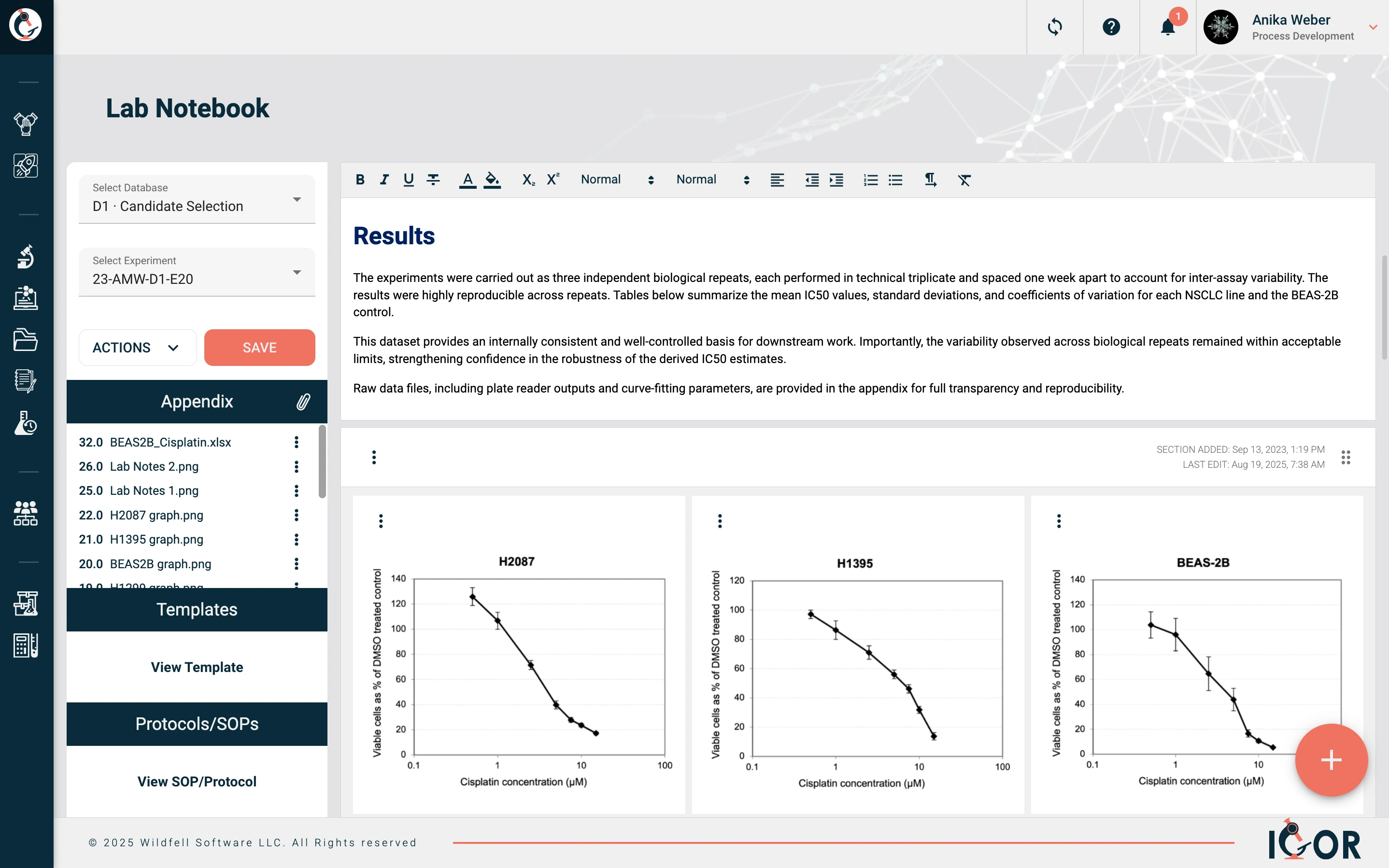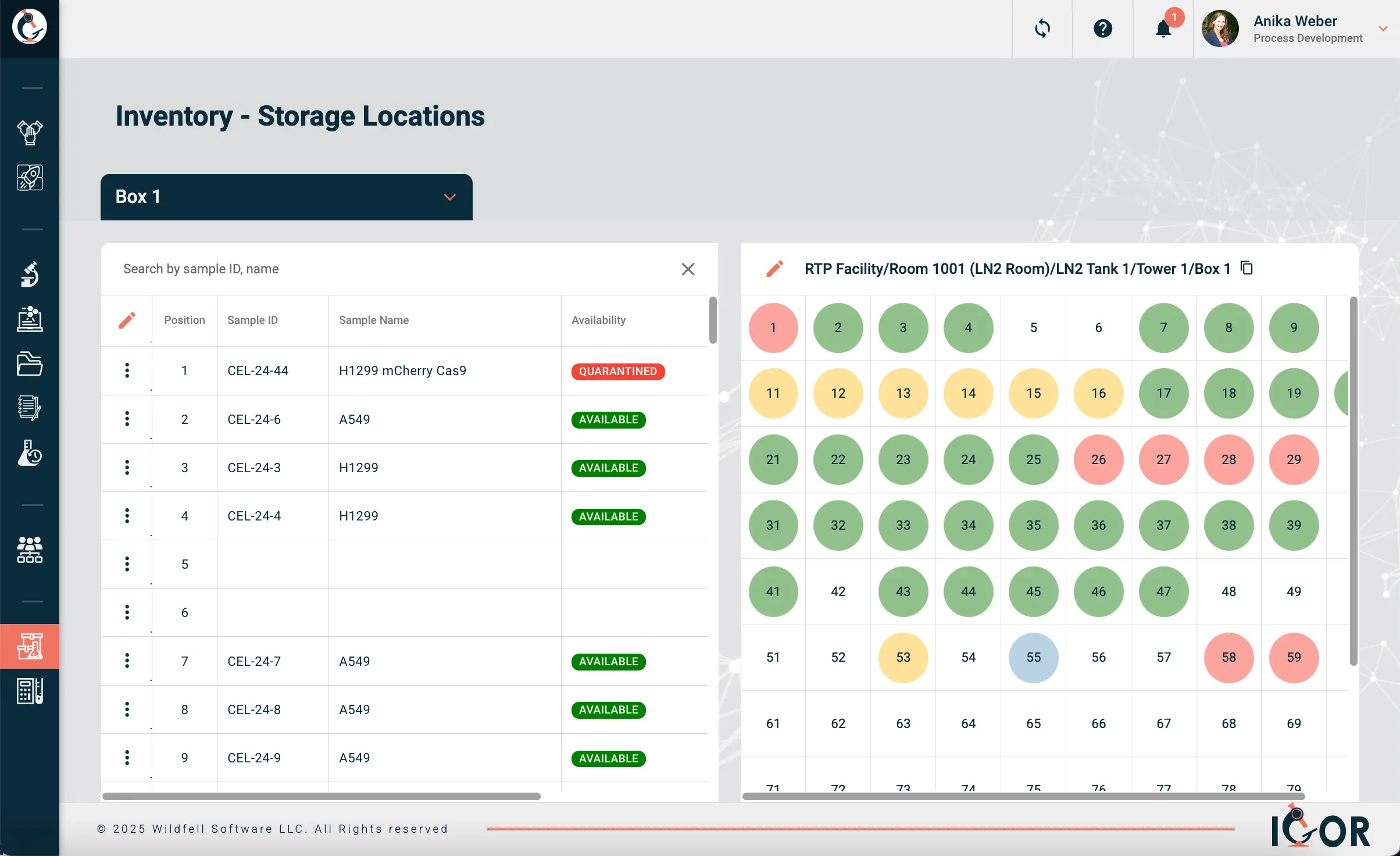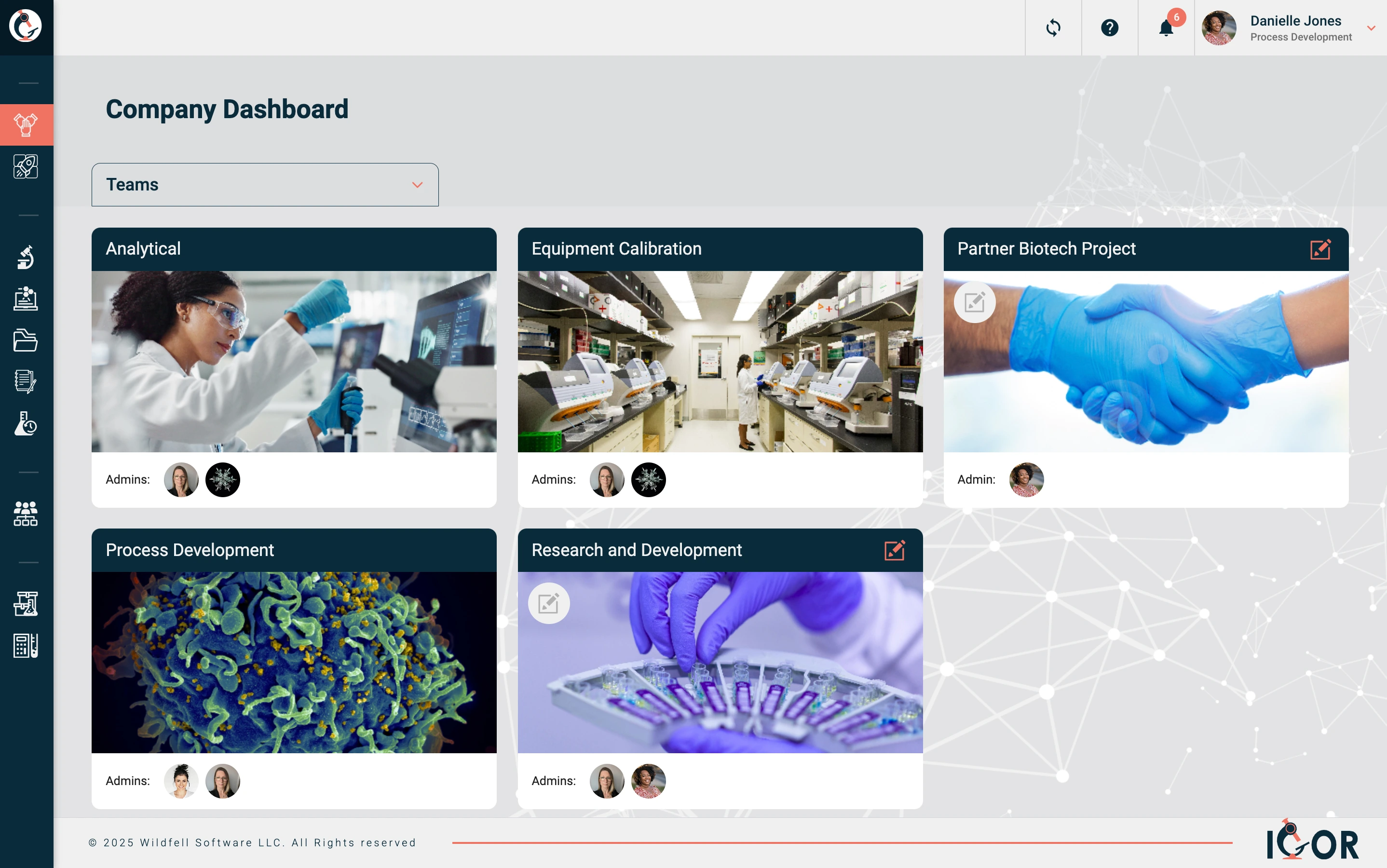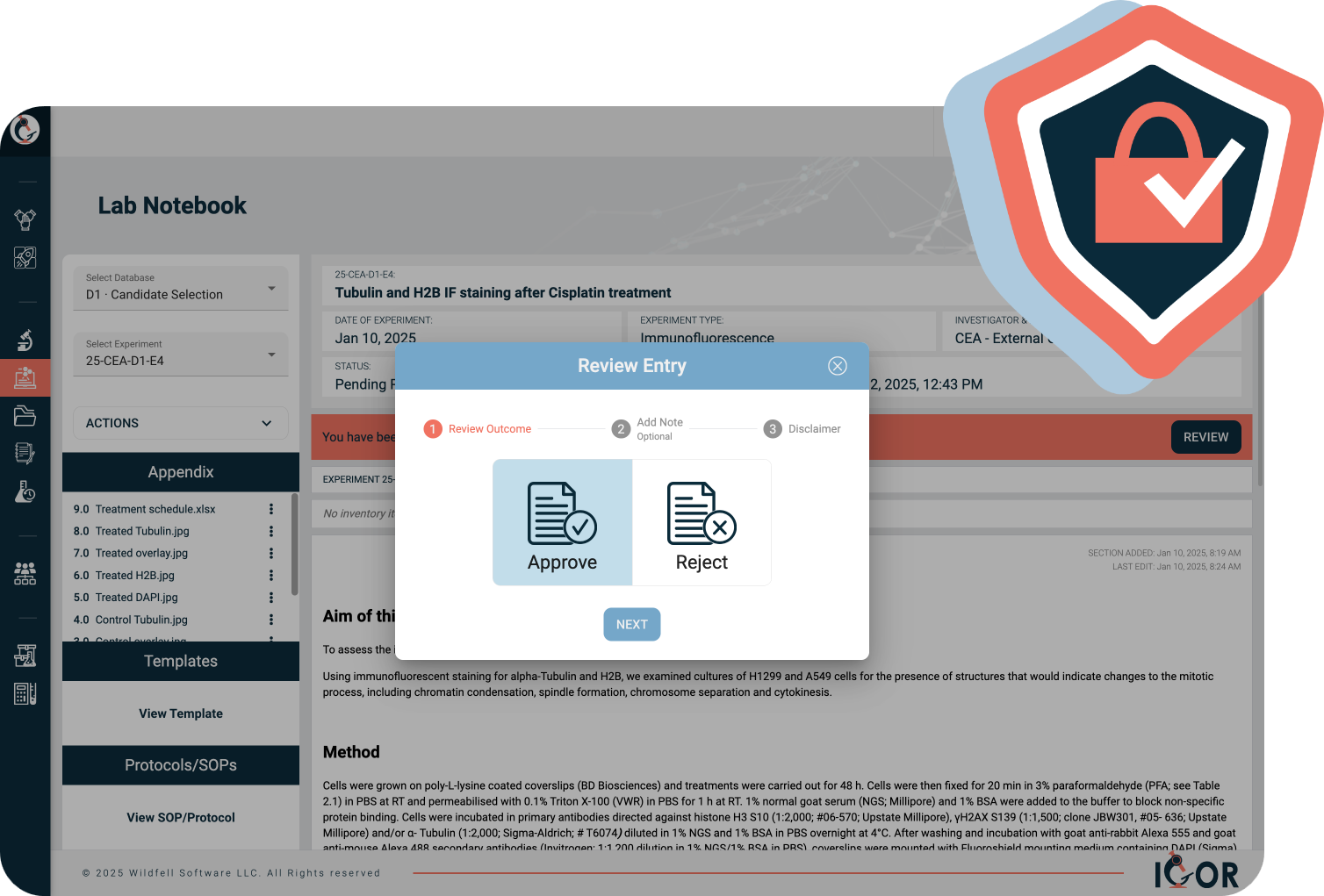



At the core of IGOR is its ELN, bringing together your notes, write-ups, SOPs, inventory, and files into one easy-to-navigate interface - complete with audit trails and digital signature workflows for full traceability.


IGOR brings your ELN and Lab Information Management System (LIMS) into a single platform, making it easy to track the full story of your experiments - from the materials you used to the results you achieved.
With advanced search functionality and interactive storage maps you can see exactly what you have on hand and where it’s stored, while relationship maps show how samples are connected to each other.
Unlike other platforms that force everyone into a cluttered one-size-fits-all setup, IGOR gives each team, department, or project group the freedom to configure their own workspace to meet their needs.
Each team controls how documentation is organized, which metadata is tracked, who has access, and which SOPs or experiment templates are in use. And when cross-function collaboration is needed, teams can easily and securely share data, templates, SOPs, or inventories across workspaces.
It’s the best of both worlds: Research teams maintain independence where needed, but stay seamlessly connected.


Whether across labs, teams, or projects, IGOR ensures collaboration happens seamlessly and productively.
IGOR safeguards your research data with advanced protection and built-in compliance tools to support teams in regulated environments.


IGOR helps your lab save time, improve reproducibility, and stay aligned with GxP best practices.
Work Faster
Customers report over 50% time saved on research documentation through experiment templates, file and inventory integration, and easy search.
Preserve Knowledge
With IGOR, your lab’s knowledge becomes an enduring asset - not something tied to individuals. Your research stays accessible, audit-ready, and future-proof.
Unify Your Data
IGOR brings experiments, samples, SOPs, and inventory into one searchable, centralized system. No more chasing files or juggling spreadsheets.
Get Expert Support
Support doesn’t stop at sign-up. From onboarding to scaling, our team of real scientists (no bots!) is here every step of the way - at no extra cost.

Whether you're leading an academic research group, launching an AgTech startup, or scaling a fast-growing biotech company, IGOR provides the tools to stay organized and compliant - today and as your team grows.
Our pricing is designed to be simple: no long-term contracts, no seat minimums, no team-size limits, and no surprise fees. Just buy what you need, when you need it - and scale on your own terms.
IGOR was designed by scientists, with a focus on making powerful features easy to use. We’ve worked hard to simplify complex functionality into a straightforward design that feels intuitive, even for first-time ELN users. No steep learning curve.
Designed for quick implementation, IGOR allows research teams to set up a customized workspace within hours. With its no-code, point-and-click configuration, scientists can adapt the platform to their workflows without needing IT support or programming skills.
Running other ELNs smoothly can be a burden, often needing extra staff or IT support. IGOR’s smart framework keeps data organized automatically, minimizing maintenance. And intuitive dashboards make the remaining admin easy to manage or delegate as needed.

Pen and paper are just too practical not to use in daily lab work. That's why they aren't going anywhere.
IGOR's mobile app honors this reality. The app allows users to capture crucial lab observations, or scan documents and handwritten notes, then securely upload them straight to their respective electronic lab notebook entry.
Going digital really is that easy!
Simplify research workflows, reduce errors, and free your team to focus on science.

Using an electronic laboratory notebook (ELN) can completely change how your lab manages data and collaborates. Like any system, it comes with both advantages and a few challenges to consider.
Advantages:
An ELN helps centralize experimental data, files, and notes in one secure, searchable location, improving overall organization and reducing the risk of data loss. Most platforms like IGOR include automated data backups and robust security measures to protect your scientific records and support regulatory compliance.
ELNs also enhance collaboration by making it easier to share data, track changes, and maintain transparency and accountability across research teams. Depending on the vendor, some ELNs (including IGOR) can also support compliance with industry standards like GxP and 21 CFR Part 11, thanks to built-in features such as audit trails, version control, and digital signatures.
ELNs can also help save time by streamlining reporting and enabling reuse of experiment templates (where available). Standardized templates also reduce human error and make it easier to reproduce experiments accurately, improving data quality and consistency. Most ELNs allow teams to quickly access past results, ensuring research continuity even as personnel change.
Some ELNs, like IGOR, also integrate lab inventory management and LIMS features, providing full context around your research. From a single platform, you can track how samples and reagents are used, follow their relationships across experiments, and check current inventory levels. With such a LIMS integration, every material’s full history is linked directly to your experiment records, helping you work more efficiently and make better-informed decisions.
In addition, platforms like IGOR offer granular access control, allowing you to set user roles and permissions to match your team’s needs. This ensures sensitive data is protected, while still enabling collaboration and access where it's needed most.
Disadvantages:
While the benefits of using an electronic laboratory notebook (ELN) are substantial, there are a few challenges to consider when making the switch. Initial setup and onboarding can take some time, especially for labs transitioning from paper-based systems or spreadsheets. However, modern platforms like IGOR are designed to simplify implementation and reduce setup time significantly. There may also be a learning curve for team members who are new to digital lab tools, but with the right training and support, most labs adapt quickly. Additionally, some ELNs may require IT support or custom development to meet specific needs (not the case with IGOR!), which can be a barrier for smaller labs.
Overall, these drawbacks are often short-term and outweighed by the long-term advantages. Modern ELNs deliver measurable improvements in efficiency, data consistency, and team productivity, often leading to a considerable return on investment.
IGOR is a modern, cloud-based Electronic Lab Notebook (ELN) and Laboratory Information Management System (LIMS) designed to help scientific teams streamline lab data management, improve research collaboration, and maintain complete traceability across their experiment workflows. It’s built to be flexible, easy to use, and adaptable to the way your lab actually works - whether you're running experiments, tracking inventory, or documenting standard operating procedures.
With IGOR, all your research data, notes, and materials live in one connected system. You can structure experiments using customizable templates, link them to samples and reagents, and keep everything traceable from start to finish. Because IGOR also includes built-in inventory management, you can track what you used, where it came from, and whether it's still in stock - without needing a separate system.
The platform also supports labs that need to follow compliance standards like GxP and 21 CFR Part 11, offering features such as tamper-proof audit trails, role-based access controls, customizable user permissions, and digital signature workflows. And because IGOR is cloud-based, your data is automatically backed up and securely accessible from anywhere.
In short, IGOR helps labs stay organized, reduce manual work, and make sure nothing gets lost - even as projects grow and teams evolve. It’s a practical way to bring your lab data, materials, and documentation together in one place.
IGOR is built for scientific research teams across industries like biotech, pharma, academia, and AgTech. It supports labs of all sizes - from small research groups to large, multi-department organizations - and adapts easily to different types of workflows. Whether you're running a startup lab, a university-based research group, or an enterprise-scale R&D organization, IGOR gives you the flexibility to organize and manage your research activities at any scale.
With IGOR’s flexible workspace system, you can keep departments, projects, or research groups clearly separated and well-organized. Each workspace can be configured independently - no coding or IT support required - so you can structure experiments, track inventory, manage user roles, and ensure compliance in a way that fits each group’s needs, while still maintaining oversight across your entire organization.
IGOR supports both regulated and non-regulated research environments, with built-in tools like detailed audit trails, document versioning, user permissions, and digital signatures to help your team meet compliance requirements when needed.
In short, IGOR is designed for labs ready to leave behind disconnected tools like spreadsheets, shared folders, and outdated LIMS systems. It provides a centralized platform that supports reproducible science, cross-team collaboration, and secure data management - without forcing your lab to change how it works.
A LIMS (Laboratory Information Management System) and an ELN (Electronic Lab Notebook) serve different, but often complementary, roles in a laboratory setting.
A LIMS is typically focused on managing the operational side of the lab - things like tracking samples, managing inventory, scheduling workflows, and ensuring compliance. It’s all about keeping the lab running smoothly and making sure materials and processes are traceable and well-documented.
An ELN, on the other hand, is more about capturing the scientific process itself. It’s used to document experiments, record observations, manage protocols, and store research notes in a structured digital format. It replaces traditional paper lab notebooks and helps research teams work together more effectively, maintain version control, and keep research organized and reproducible.
While traditional systems kept these functions separate, some modern platforms like IGOR combine both ELN and LIMS functionality, giving labs a complete solution for data capture, sample tracking, and compliance in one place. This not only reduces the need for multiple tools, but also gives researchers full context across every part of the research lifecycle.
Choosing the best lab software really comes down to how your lab works day to day - your team size, number of departments, workflows, regulatory needs, and of course, your budget. The ideal platform is one that checks off the basics: easy to use (meaning an intuitive interface where your team doesn’t need weeks of training), customizable so it can reflect your specific data structures and experiment types, scalable so it can grow as your team or the complexity of your work grows, compliant with features like audit trails and digital signature workflows, and well supported with training, documentation and responsive vendor support.
In your evaluation of available tools, it's advisable to start with usability, as that is the number one factor affecting adoption. If it isn’t intuitive enough that your team can jump in with minimal training, it’s not the right fit. Ask for a demo or trial so you can actually test how it feels to use.
As you compare options, you’ll meet plenty of polished sales teams eager to dazzle you with slick dashboards, AI buzzwords, and layers of automation to entice you to buy their tool and pricey add-ons. Don't get caught up in the excitement, but focus on the problems you’re trying to solve, and the tools you actually need to solve them. The rest often just adds unnecessary complexity and maintenance headaches.
Look for something customizable enough that scientists - not IT or software engineers - can adjust your workspace setup and templates as your research evolves.
On the cost side, dig deeper than the subscription price; some vendors tack on extra fees for onboarding, support, or even basic customization. And be cautious of “free” systems - they usually come with trade-offs in storage, functionality, or security.
In the long run, a platform that’s easy to use, flexible, and transparent about pricing - like IGOR - saves you far more time and frustration than a complicated or limited system ever will.